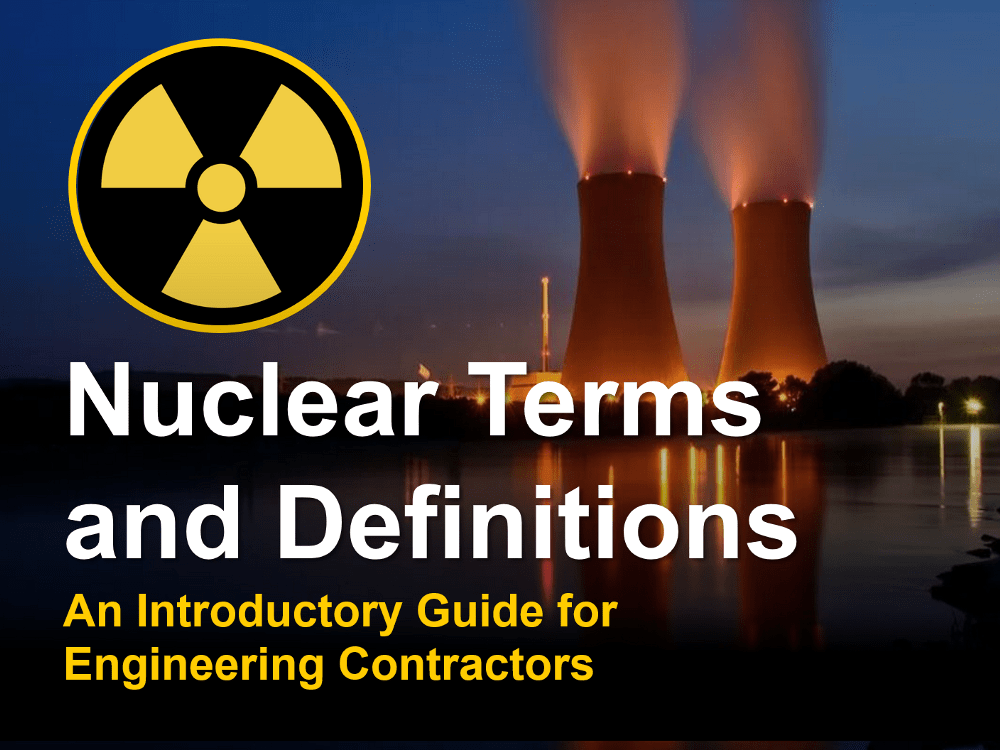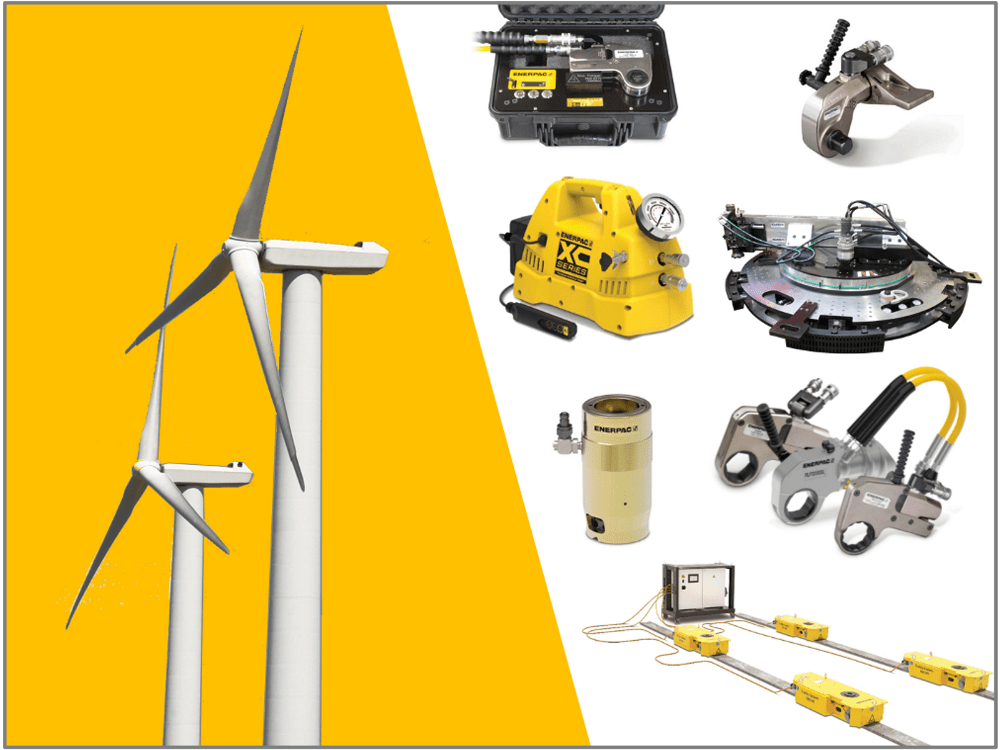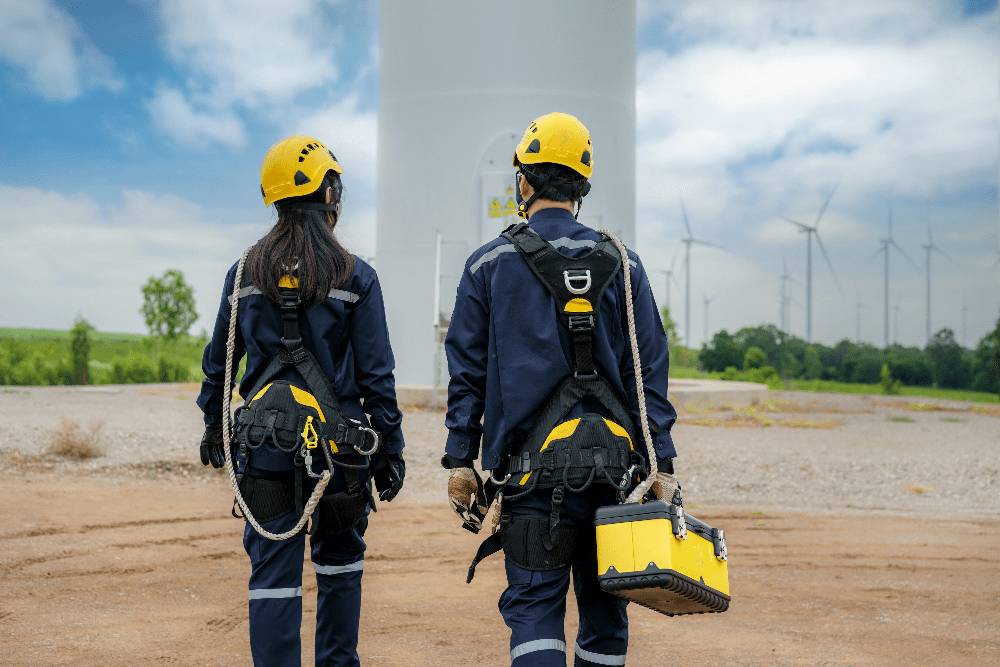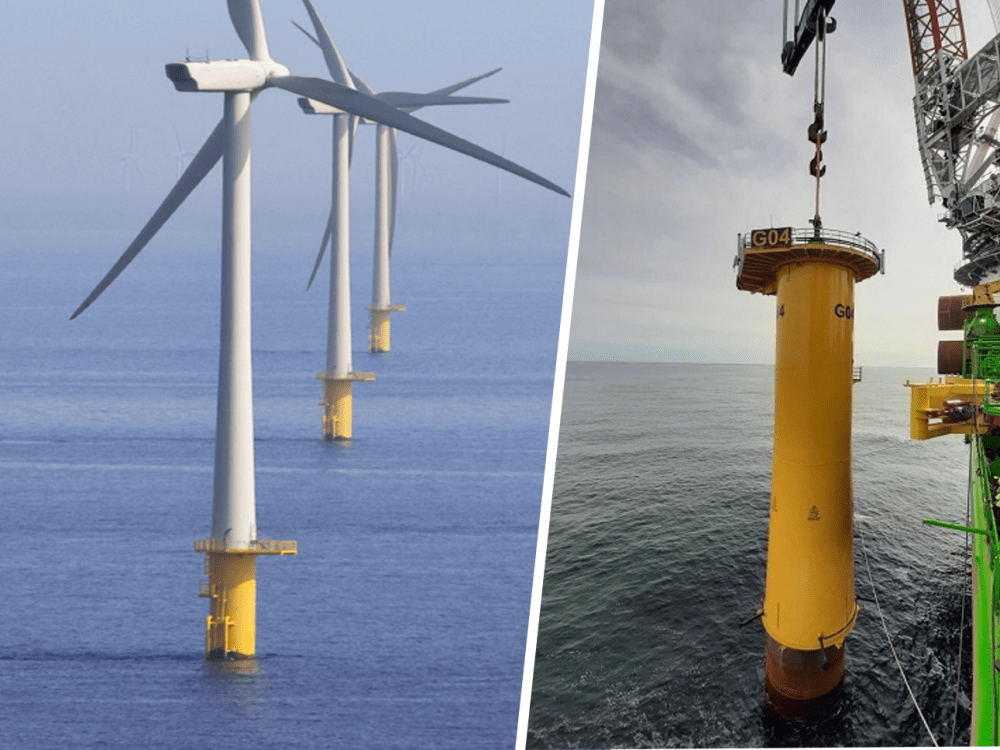Wind Power Terms and Definitions
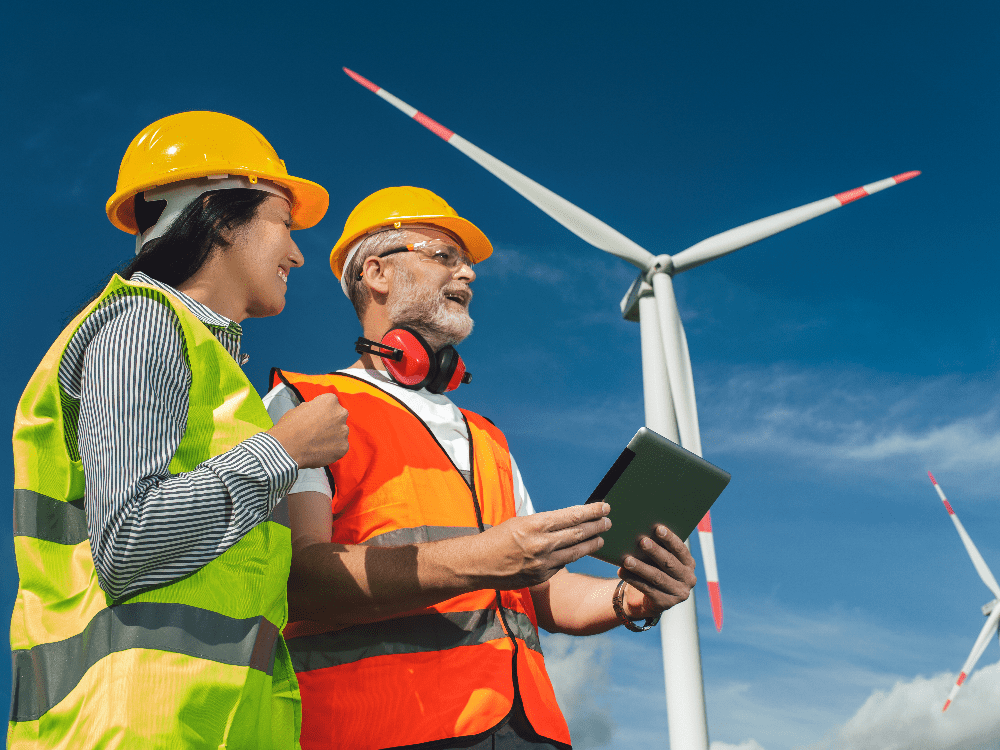
March 23, 2021
0
Having knowledge of commonly used wind power terms is useful if you intend to work in this growing sector. Many industries have their own selection of confusing acronyms and technical jargon, and the wind power market is no exception.
Anyone new to the industry could be forgiven for feeling a little bewildered when hearing about ‘Cogging’, ‘Betz Coefficient’, or a ‘FOWT’.
That’s why we’ve created an ‘Essential Guide to Wind Power Terms and Definitions’ to help those who plan to work in the wind power sector.
Wind Power Terms and Definitions: A Glossary
Adequacy
This is a measure of the power system’s ability to supply the aggregate electric power requirements of the customers. It considers the planned and unplanned outages of system components.
Aggregation
Bundling wind projects together to benefit from economies of scale and sharing costs.
Airfoil
Cross section of the turbine blades. A turbine blade design to improve aerodynamics and noise control. As on an airplane wing.
American Clean Power (ACP)
A federation of renewable energy companies promoting the advancement of clean energy in America.
Anemometer
A device that is used to measure wind speed.
Armature
The moving part of the alternator. Normally carries the magnets and is attached to the blades and hub.
ARENA
Australian Renewable Energy Agency.
Availability Factor
The percentage of time a wind turbine works and is not out of use due to maintenance or repairs.
Balancing
Adjusting turbine blade weight and weight distribution through two axes to make them the same. An unbalanced blade creates damaging vibration.
Betz Coefficient
59.3 percent. The theoretical maximum efficiency at which a wind generator can operate by slowing the wind down. If it slows down too much, air builds up in front of the blades and is not used for extracting energy.
Balance of Plant (BOP)
A wind farm comprises of many items. BOP means everything excluding the turbines, for example, civil works, SCADA system (Supervisory Control And Data Acquisition), internal electrical system, and grid connection.
Blades
Turbine blades harness the wind to drive a rotor of a wind turbine.
Braking System
Although the purpose of a wind turbine is to use the wind to generate power, if the turbine rotates too quickly, there is the risk of mechanical damage or fire. The braking system slows a wind turbine’s shaft speed down to safe levels (electrically and mechanically).
Capacity
The rated continuous load-carrying ability of generation or transmission. This is expressed in megawatts (MW) for active power, or megavolt-amperes (MVA) for apparent power.
Capacity Factor
This is the measure of wind turbine productivity. It is calculated by the amount of power that a wind turbine produces over a set time period, divided by the amount of power that would have been produced if it had operated at full capacity during that same time period.
Cogging
Otherwise known as magnetic locking. Cogging in permanent magnet generators can hinder the start-up of small wind turbines at low wind speeds.
Controlled Shutdown
A method of stopping a wind turbine that ‘feathers’ the blades slower than an Emergency Shutdown – therefore causing less stress on the structure.
Chord
The width of a wind turbine blade. This can be measured at any given location along the length.
Commercial Scale Wind
Wind energy projects greater than 100 kilowatts, in which the electricity is sold rather than used on-site. This could be either 100 or more turbines owned by large corporations, or a single locally owned wind turbine greater than 100 kilowatts.
Community Wind
Locally owned, commercial-sized wind projects, where one or more members of the local community has a significant direct financial stake in the project.
Cut-In Speed
The wind speed at which turbine blades begin to rotate and produce electricity, typically around 10 miles per hour.
Cut-Out Speed
The wind speed, usually around 55 to 65 miles per hour, at which some wind turbines automatically stop the blades from turning – rotating out of the wind to avoid damage.
Cowling
The cover which houses the main workings of the turbine. (See Nacelle).
Darrieus Rotor
A vertical axis wind turbine (VAWT) developed by French inventor G. J. M. Darrieus in 1929. It uses lift forces generated by the wind hitting aerofoils to create rotation. Slender by comparison to the more common horizontal axis wind turbine
Downwind Turbine
A horizontal-axis wind turbine where the hub and blades point away from the wind direction.
Diffuser
A downwind device that diffuses the wind stream through a rotor
Direct Drive
A drive-train concept for wind turbines without a gearbox. The rotor is connected directly to a low-speed electrical generator.
EWEA
European Wind Energy Association. (Now called Wind Europe).
Fixed Turbine
An offshore wind turbine structure permanently fixed to the seabed.
Foundation
The system securing the turbine to the geological formation around the footing. Read the case study explaining how an Enerpac Synchronous Hydraulic Lifting System was used.
FOWT
Floating Offshore Wind Turbine
FTU
Floating Turbine Unit
Full Load hours
A turbine’s average annual production divided by its rated power.
Feathering
Changing the pitch angle to turn the blades parallel to the airflow. This acts as a brake.
Footing
The base, (sometimes concrete), that secures the turbine in place. If on bedrock the footing uses rock anchors to secure a relatively small concrete footing (about 220 tonnes for a 2MW turbine). If there’s no suitable bedrock heavier gravity footings are used, that are capable of holding the turbine in place without any attachment to underlying materials.
Furling
The act of a wind turbine head yawing (rotating) out of the wind, either horizontally or vertically, to protect itself from high wind speeds.
FWE
Floating Wind Energy
Gigawatt
A unit of power equal to 1 billion Watts, 1 million kilowatts, or 1,000 megawatts
Giromill
Also known as a cycloturbine. A vertical axis in a H configuration with articulating straight blades.
Grid-connected
A wind turbine is grid-connected when its output is channeled directly into a regional or national grid.
Green Pricing
Used by some power providers whereby electricity produced from clean, renewable resources is sold at a higher cost than electricity produced from conventional fuels. The intention is to appeal to buyers prepared to pay more for cleaner power.
Guy Anchor
Attaches guy wires attached to the tower to the ground.
Guy Radius
Distance between a wind turbine tower and the guy anchors.
HAWT
Horizontal Axis Wind Turbine.
Hub
The central part of the wind turbine. The section which supports the blades on the outside and connects to the low-speed rotor shaft inside the nacelle.
Hybrid System
Combination of different energy-producing technologies. For example, solar electric systems and wind turbine systems.
Inverter
A device that converts DC electricity to AC current. This may be for either stand-alone systems or to supply power to an electric utility system.
Jacket
The lower section supporting the tower. An X- braced metal framework.
Katabatic Wind
A cold downhill flowing wind accelerated by gravity. Examples include winds that blow off the Antarctic Plateau toward the coast, or gully winds.
Kilowatt
A standard unit of electrical power = 1,000 Watts
Megawatt
Another standard measure of electric power. = 1,000 kilowatts (1 million watts).
Main Turbine Controller (MTC)
This controls the wind turbine by gathering and monitoring data from various turbine components and systems, for example, the data is used to adjust pitch angle, yaw direction, and fault conditions.
Nacelle
The structure at the top of the wind turbine tower that houses the key components of the wind turbine, including the rotor shaft, gearbox, and generator. Sometimes described as the Cowling.
NIMBY
Acronym for ‘Not In My Back Yard’. Sometimes used as an explanation of local resistance to projects.
O&M
Operations & Maintenance
Payback Period
The time required for the savings to equal the initial equipment and setup cost.
Peak Wind Speed
The maximum wind speed within a specific time period where the turbine is located.
Power Curve
A graph displaying the instantaneous power output of a turbine design at various wind speeds. Useful to assess the potential for electricity generation at a proposed project site.
Rated Wind Speed
The wind speed at which a wind turbine reaches its rated capacity level of power production. For most small wind turbines, this is around 30 to 35 miles per hour.
Rotor
The visible spinning parts of a wind turbine. The turbine blades and the hub.
Reynolds Number
The number describing the aerodynamic state of an operating aerofoil. Used along with the angle of attack to describe the limits of a particular aerofoil’s lift-to-drag ratio and the conditions at which stall occurs. Example: Small wind turbine aerofoils typically operate in a low Reynolds number range, from 0.150 to 0.5 million.
Rock Anchor
Where rock is beneath the turbine footing, steel rods are used to anchor the turbine and footing to the underlying bedrock. Doing this reduces the amount of concrete that would otherwise be necessary. If there is no suitable bedrock within a few meters of the surface, then gravity footings are needed.
Root End
The end of the turbine blade bolted to the hub. The root end needs to be perfectly flat. During manufacturing, these are machined using an Orbital Milling Machine.
Start-Up Speed
The wind speed at which a wind turbine rotor starts to rotate. A turbine does not produce any power until the wind reaches cut-in speed.
Suction Pile
An anchoring point used to secure offshore wind turbines. A steel tube with a pumping device to penetrate the seabed.
Small Wind Turbine (SWT)
A wind turbine system with 300 sqm of rotor swept area or less.
Stall-Regulated Wind Turbine
A turbine with fixed blades where the pitch cannot be adjusted. As wind speed approaches the cut-out speed, the aeroelastic properties of the blades act as an inherent braking method.
Survival Wind Speed
The maximum wind speed that a turbine is designed to withstand before damage occurs.
Thrust Bearing
A bearing designed to handle axial forces along the centerline of the shaft. The axial force caused by the wind pushing back against the blades.
Thrust Curve
A graph showing the force applied by the wind at the top of the tower related to wind speed.
Tower
The base structure supports and elevates a wind turbine rotor and nacelle. The wind turbine tower is constructed from circular sections which are bolted together. Joint integrity is carried out using hydraulic torque wrenches. The wind tower sections can be aligned using Equalizer Wind Tower Flange Alignment Tools.
Turbine
A device for converting the flow of air, steam, water, or hot gases into mechanical motion that can be utilized to produce electricity.
Turbine Lifetime
The expected total lifetime of the turbine (normally 20 years).
TW (Terawatt)
A Terawatt is a mind-boggling 1,000,000,000,000 Watts or One Trillion Watts. To put this into perspective, this metric is used when considering the energy consumption of countries and continents.
Twist
The difference in pitch between the turbine blade root and the blade tip. For an optimum high-speed performance, there is more pitch towards the blade root than there is at the tip.
Tail
See Vane, which is the more correct term.
Tail Boom
A strut that holds the tail (Vane) to the wind generator frame.
Tip Speed Ratio (TSR)
The ratio of how fast the blade tips are moving compared to wind speed.
Utility-Scale Wind
Wind energy projects greater than 100 kilowatts in capacity in which the electricity is sold rather than used on-site. This category can be either large groups of turbines owned by corporations, or a single locally owned wind turbine greater than 100 kilowatts in size.
U-Shape Curve
A model stating shifting public attitudes towards wind farms. Often positive, before the announcement of the project, then negative when the project is announced, and back to positive after the construction.
Vane
A large, flat piece of material used to align a wind turbine rotor correctly into the wind. Usually mounted vertically on the tail boom. Sometimes called a tail.
Variable Pitch Turbine
A type of wind turbine rotor where the attack angle of the blades can be adjusted.
Vertical Axis Wind Turbine
A design in which the axis of rotation is perpendicular to the ground and the cups or blades rotate parallel to the ground.
WFCM
Wind Farm Cluster Management. The aggregation of geographically dispersed wind farms, according to various criteria, for optimised network management and generation scheduling.
Wind Monitoring System
A group of instruments, such as anemometers and wind vanes. Used to measure weather conditions such as wind speed, wind direction and temperature at various heights above the ground.
Wind Farm
A collection of wind turbines with integrated operation. Supplying electricity to the electrical grid, via one or more substations.
Wind Atlas Analysis and Application Program (WAsP)
A program for predicting wind climate and energy production from wind farms.
Wind Power Class
Rating system from 1 to 7, to state the quality of the wind resource in an area. It is based on the average annual wind speed. 1 = the poorest. 7 = exceptional.
Wind Shear
A term and calculation used to describe how wind speed increases with height above the surface of the earth.
Wind Vane
A device used to measure wind direction.
Winds Resource Assessment
The potential wind energy available for use based on historical wind data, topographic features, and other parameters. Used by developers to estimate the future energy production of a wind farm.
Yaw
The rotation of a horizontal-axis wind turbine above its tower or vertical axis. Depending upon the design, the wind turbine is rotated to face the oncoming wind.
Zone of visual influence (ZVI)
This is the area of land around a wind farm from where a specified number of turbines can be seen. ZVI is often presented on a color-coded map.
We hope you find this glossary of wind power terms useful. If you think we’ve missed anything, leave a comment below.
Also, take a look at Enerpac.com to learn about wind power applications for Enerpac industrial tools.
Wind Power Terms Sources and External Websites
See these external sites for more detailed information about terms.
